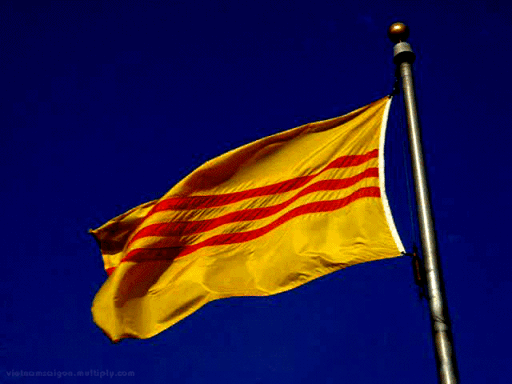Why You’re Ignorant AF for Using the Northern Vietnam Flag Emoji in America
For many Asian Americans who have spent a significant amount of time away from their homeland, a nation’s flag can evoke a sense of pride, nationalism, and oftentimes, a deep longing to return to their country of origin.
This is not usually the case, however, for many overseas Vietnamese (Việt kiều), especially those whose family fled Vietnam in the late 1970s and 1980s as “Boat People.” For them, their current flag instead brings back images of dread, fear, and disdain as it reminds them of the communist regime their families opposed and escaped from.
“The trauma of losing the war has been extremely difficult for the older generations of Vietnamese Americans to come to terms with fully,” Aaron Lillie, who teaches Southeast Asian History and the Vietnam Wars at the University of Washington told NextShark. “From the perspective of many older Vietnamese who supported the Republic during the 1960s and 70s, the current flag of Vietnam remains the flag of an old enemy with whom they have never reconciled.”
While it has been 44 years since the Vietnam war ended, the memories of its horrors continues to evoke a strong response from Vietnamese Americans who can’t stand even the mere sight of the current flag in emoji form.
In fact, a significant number of overseas Vietnamese have been petitioning Apple, Google and the Unicode Consortium to create an emoji for the South Vietnamese national flag, the flag of what was once the Republic of Vietnam from 1948 to 1975.
“A large part of Vietnamese Heritage comes from a time before the Vietnam War. As Vietnamese-Americans, the descendants of those who fled mainland Vietnam, it is only just that we celebrate the flag which encompasses our cultural identity. For many Vietnamese, this is the flag which we choose to fly our colors at our celebrations,” one of the petitioners wrote.
“It’s important to remember the history and the reasons why we left the mainland, and by signing this petition, you are taking action to preserve our beautiful legacy. One small emoji change might not seem like a big deal, but, it’s the beginning of a movement, one which starts with letting the world know the importance of our culture to us.”
While the South Vietnamese state ceased to exist when the Vietnam War ended, its flag is still being used by many Vietnamese Americans as the symbol of their nationality. The same is true for Vietnamese Canadians in Canada, Vietnamese Germans in western Germany, for Vietnamese in the Netherlands, France, Norway, and Australia.
“For them, the flag of the Republic also still retains some importance as a symbol of remembrance for what was lost during the war,” Lillie explained.
The flag, which consists of a yellow field and three horizontal red stripes, is now recognized as the “Vietnamese Heritage and Freedom Flag” (Lá cờ Tự do và Di sản) by at least 13 U.S. state governments, seven counties and 85 cities in 20 states in the U.S.
But while the Vietnamese Heritage and Freedom Flag can be seen daily in many areas where many people of Vietnamese origin live, such as the streets of Little Saigon in Los Angeles, displaying it in communist-run Vietnam today is avoided as it risks government prosecution.
This is hardly an issue for many living in Vietnam as most have either embraced the “Red Flag with a Gold Star” as their national symbol or just abided by the patriotism and party loyalty that the government expects from its people.
“In Vietnam, a significant majority of people have moved on from the war,” Lillie noted. “Vietnam today is a very young country. However, the older generations that survived the 1960s and 70s still often tend to be intensely patriotic and display the flag, but displaying the flag can be compulsory at times. Displays of patriotism and party loyalty are strongly encouraged by the government. Separating genuine patriotism from the desire for approval from the Communist Party can be difficult.”
He further shared that the younger generation appears to have become “cynical about government propaganda and largely indifferent to the patriotic symbols of the Vietnamese revolution.”
According to Lillie, the current flag holds significant importance to the government as its revolutionary past helps cement its claim to power.
“The current government of Vietnam uses the flag to connect itself to the revolutionary past. That connection with its past as the government that defeated both the French and the Americans is extremely important for maintaining its legitimacy as the current government. A large majority of Vietnamese are proud of their success in the Vietnamese struggle for independence, even if many of them don’t much care for the government in Hanoi.”
For San Jose City Councilman Tam Nguyen, the flag is a “symbol of tyranny, oppression, and dictatorship” so he moved to ban the flag of the communist Socialist Republic of Vietnam in his city in 2017. Nguyen, who fled Vietnam when he was 19, said he introduced the resolution because he felt the city shouldn’t spend money and resources to fly the flag, NBC reports. A similar resolution was passed by Westminster the year before.
“The [Vietnamese] community in San Jose escaped that flag and we just want to live in peace without being reminded of the painful past,” he was quoted as saying.
Featured image (left) via Flickr/eric molina and (right) via Flickr/InSapphoWeTrust
The post Why You’re Ignorant AF for Using the Northern Vietnam Flag Emoji in America appeared first on NextShark.
Contributer : NextShark



 Reviewed by mimisabreena
on
Saturday, June 15, 2019
Rating:
Reviewed by mimisabreena
on
Saturday, June 15, 2019
Rating:

















No comments:
Post a Comment